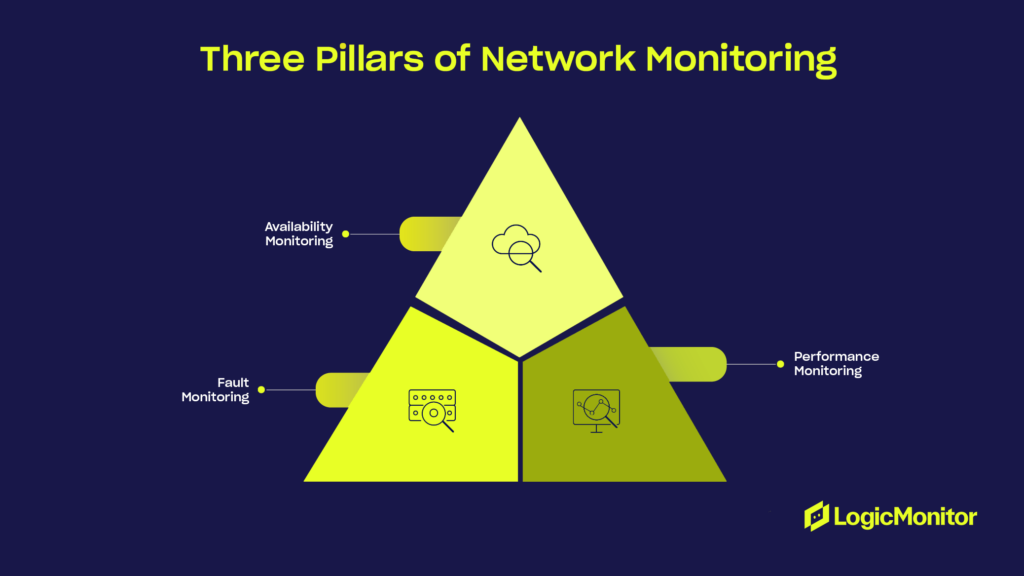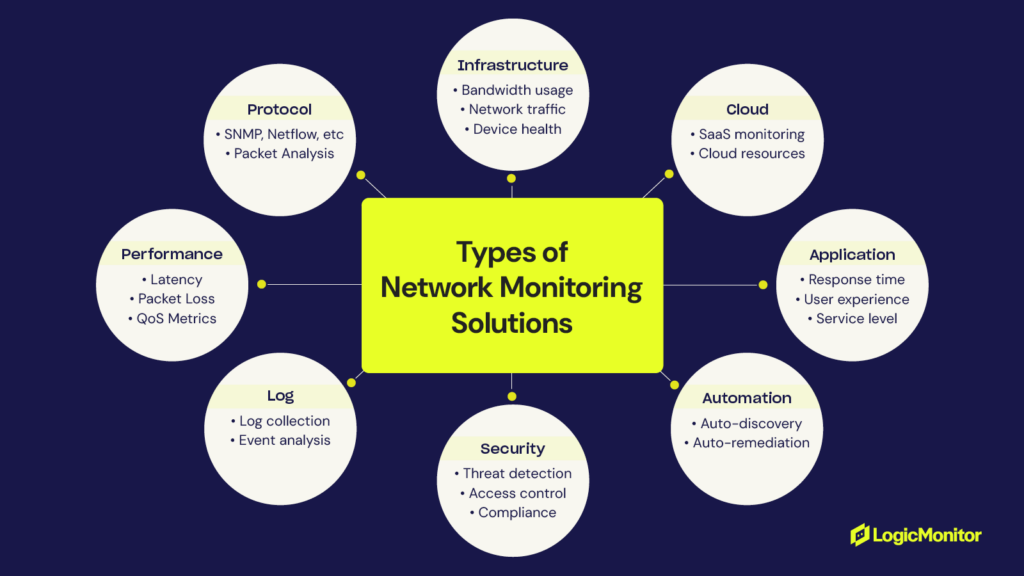The Three Pillars of Network Monitoring: A Holistic Strategy


To truly safeguard your infrastructure, it’s crucial to adopt a holistic strategy that covers every aspect of your network’s health and performance. This means integrating fault monitoring, performance monitoring, and availability monitoring into a comprehensive strategy. Lets discuss how a well-rounded approach to network monitoring can help you maintain resilience, optimize performance, and prevent downtime.
Think of network monitoring as a three-legged stool supported by the following essential pillars.

Fault monitoring is like having a smoke detector for your network. It’s your first line of defense against potential issues, focusing on detecting errors and anomalies that could lead to disruptions or outages.
Pro tip: Log aggregation tools that centralize and analyze logs from all your network devices are invaluable. They can help you detect patterns that indicate a systemic issue, such as frequent port resets or protocol timeouts across multiple devices.
Pro tip: Use AI-powered alert correlation to group related alerts and reduce noise. This prevents alert fatigue and helps your team focus on the root cause of problems.
Pro tip: Integrate fault monitoring with your configuration management systems. This allows you to compare device settings and change logs in real time, helping you trace faults back to specific configuration changes or deployments.
Performance monitoring is like having a fitness tracker for your network. It’s all about tracking key performance metrics to ensure that your systems are operating at peak efficiency and delivering a seamless user experience.
Pro tip: Implement dynamic baselining to track performance metrics in real time and adjust thresholds based on historical data. This helps you avoid false positives and focus on true anomalies.
Pro tip: Use predictive analytics to forecast future resource needs based on current performance trends. This allows you to proactively plan upgrades or allocate additional resources before bottlenecks occur.
Availability monitoring is like having a reliable backup generator. It focuses on ensuring that critical resources, such as servers, databases, and applications, are available when needed, minimizing downtime and ensuring business continuity.
Pro tip: To enhance uptime monitoring, deploy synthetic testing, where artificial requests simulate user behavior to proactively test the availability and responsiveness of your services.
Pro tip: Automate SLA reporting to provide real-time compliance data to stakeholders and proactively address potential violations.

A solid network monitoring setup brings together fault monitoring, performance monitoring, and availability monitoring for a unified, reliable way to manage your network. By combining these three key pieces, you can stay ahead of potential problems, boost performance, and keep services running smoothly. Here’s a quick look at how these elements work together to create a stronger network monitoring strategy:
A unified framework consolidates data from fault, performance, and availability monitoring into a single, real-time dashboard. This integrated approach provides IT teams with a holistic view of network health, performance metrics, and availability. By centralizing and visualizing this data in one location, critical issues are less likely to be missed, and troubleshooting becomes significantly faster and more efficient.
Integrating fault, performance, and availability monitoring enables organizations to detect and mitigate potential problems before they escalate. For instance, performance monitoring can identify resource utilization trends that may result in faults, while availability monitoring ensures that backup systems are ready to handle potential disruptions.
When fault, performance, and availability monitoring work in synergy, they deliver more comprehensive and actionable insights. Examples of this collaboration include:
By adopting an integrated approach that unites fault, performance, and availability monitoring, organizations can achieve a more proactive, insightful, and effective network monitoring strategy, ensuring their infrastructure remains resilient and well-prepared to address potential challenges.
By integrating fault monitoring, performance monitoring, and availability monitoring, you can create a comprehensive strategy that strengthens your infrastructure’s resilience.
This holistic approach ensures that every aspect of your network is continually optimized, empowering you to identify and address issues before they disrupt operations proactively. With a strong focus on maintaining peak performance and reliability, your users will experience seamless, uninterrupted service.
Ready to learn more about building a resilient IT infrastructure? Dive deeper into how to avoid alert fatigue in network monitoring.
To reduce alert fatigue, implement AI-powered alert correlation and set role-based notifications. This helps group related issues and ensures alerts only reach the people who can act on them, cutting down on noise.
Use lightweight agents or SNMP-based polling for performance monitoring. Also, tools that support dynamic baselining help you to detect true anomalies without constantly triggering alerts for normal variations in network traffic.
Latency tracks how fast data travels between points, while availability monitoring checks if services are accessible at all. You might have good uptime but high latency, which still creates poor user experience, so you need to monitor both.
Regularly schedule failover tests and simulate outages to confirm your redundancy verification processes. Simply installing backups isn’t enough, make sure systems like load balancers or secondary data centers are properly configured and ready to take over.
If you notice consistent trends in bandwidth usage, CPU spikes, or memory limits across multiple devices, it’s a sign your network might need scaling. Use predictive analytics to plan upgrades before users start noticing slowdowns.
Dependency mapping shows how systems are interconnected, helping you identify whether a failure is isolated or causing a chain reaction. This speeds up root cause analysis and prevents you from chasing surface level issues instead of solving the real issue.
© LogicMonitor 2025 | All rights reserved. | All trademarks, trade names, service marks, and logos referenced herein belong to their respective companies.
